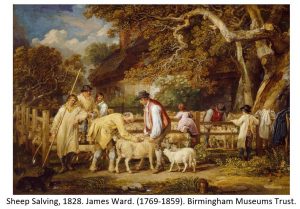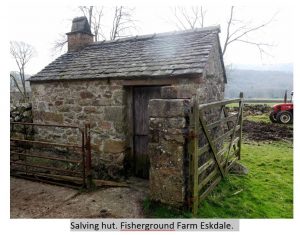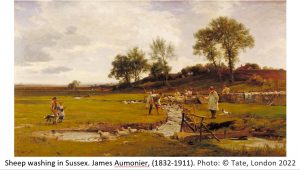Though this survey focussed on washfolds, sheepwashing was in fact just the end part of an agricultural process that was practiced prior to the introduction of sheep dip towards the end of the 19th century. To protect the sheep from parasites and to add water resistance over winter, sheep were “salved” with a mixture of tar and fat. In this 19th century painting by James Ward. The shepherds can be seen parting the wool and working the salve into the depths of the fleece.
The salve was prepared by heating up the ingredients and an example of a hut, equipped with stove and chimney to prepare salve is still present in Fisherground Farm in Eskdale close beside a modern sheep dip.
The salve on the wool reduced the sale value of the fleece creating the need for washfolds to allow sheep to be cleaned after the winter prior to shearing.
Thanks to Steve Clarke of Gosforth we have two poetic references to sheep washing:
In June wash thy sheep where the water doth run:
And keep them from dust but not keep them from sun.
Then shear them and spare not, at two days anende,
The sooner the better their bodies amend.
Thomas Tusser 1557
Shrill whistles barking dogs and chiding scold
Drive bleating sheep each morn from fallow fold
To wash pits where the willow shadows lean
Dashing them in their fold stained coats to clean
Then turned on sunning sward to dry agan
They drove them homeward to the clipping pen
John Clare 1827
In Far from the Madding Crowd, written in 1874 and set in southwest England, Thomas Hardy describes the protagonists, Bathsheba and Boldwood, meeting at the sheepwash held at the end of May. A crowd is gathered there.
“Flagons of cider were rolling about upon the green. The meek sheep were pushed into the pool by Coggan and Matthew Moon, who stood by the lower hatch, immersed to their waists; then Gabriel, who stood on the brink, thrust them under as they swam along, with an instrument like a crutch, formed for the purpose, and also for assisting the exhausted animals when the wool became saturated and they began to sink. They were let out against the stream, and through the upper opening, all impurities flowing away below. Cainy Ball and Joseph, who performed this latter operation, were if possible wetter than the rest; they resembled dolphins under a fountain, every protuberance and angle of their clothes dribbling forth a small rill.”
Far from the Madding Crowd. Chapter 19, The sheep washing. Thomas Hardy.
A contemporary painting confirms the details he describes, almost as an illustration from the book, though without the beautiful Bathsheba.
Clearly here, in southern England, the sheep are directed by pens formed by wooden hurdles rather than stone washfolds as we see them in Cumbria. The mention of cider flagons highlights that the sheepwash must have been a social occasion also.
Philip Minchom
- Rent a Peasant. Living history with livestock. http://www.rentapeasant.co.uk/activities/salving-smitting-and-smorring/
- Sheep Salving, 1828. James Ward. (1769-1859). Birmingham Museums Trust.
- M. Horner of Buckden salving sheep in a field at Cray ( Langstrothdale) 1965. Kissling, Werner (1895-1988). University of Leeds Library.
- Hardy T; Chapter 19 The sheep washing – the offer. Far from the Madding Crowd. Cornhill Magazine. 1874.
Return to Washfold Home Page



